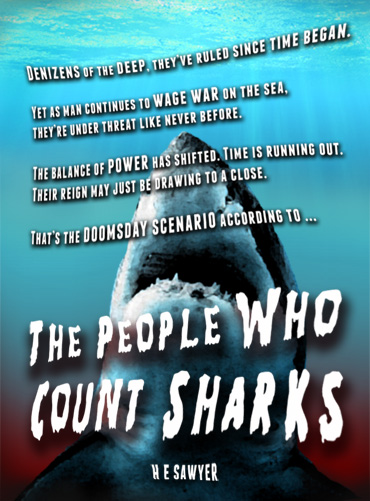
choose an article
|
|
It's estimated that there are 100 million sharks killed every year. This total has such caché it even has its own moniker; ‘The Magic Number'. But in today's world, where big numbers wash over us with indifference, ‘One Hundred Million' is losing it's lustre. Most of us owe that on our credit cards. So shark conservationists are continually polishing ‘The Magic Number' to keep us hooked. Scare mongering or just plain scary? Sharks are under threat, no question, but unlike other fish on the dock, apex predators are fortunate, because there's no shortage of dedicated, well-funded activists, celebrities and scientists queuing up to champion their cause. Saving sharks is marketed, just like Coca-Cola. As a recreational scuba diver, I'd barely qualified before the programming started. The shark conservation faction within diving is like an extension of the Jehovah's Witnesses. You could never say you hadn't heard ‘The Truth'. But if we were the good guys, kitted out like Eco Special Forces in our black neoprene, who were the bad guys? And what were they wearing? Conveniently the bogeyman turns out to be Asia, commercial tentacles reaching out to acquire shark fin for soup. Cue finger pointing and propaganda in what's become, ‘The Great Pelagic War of the Third Millennium', when in truth the UK, the EU, the world and his mother are fishing for shark for the Asian market like there's no tomorrow. When we imagine the shark, we most likely reference something from James Bond, but they range from the dwarf lantern shark, a deep sea dweller the size of your hand, to the battered piece of rock at your chippy, six quid and change with a portion of chips. Don't worry that you only imagined an archetypal example, because when conservationists dim the lights and run the film, the lone shark twisting lifeless on a line will be one you'll recognise, one that will tug the heart strings. The extended family also includes rays, skates and chimaeras, a strange looking fish-cum-ray that lives below 200 meters. (I had to look it up.) Stephen Fry is a National Treasure. He's also one of the most lucid, intelligent individuals to grace our television screens, and possesses a burning passion for conservation. (He'd definitely wouldn't need to ‘Google' a chimaera.) As quiz master on the BBC's ‘QI', he put the number of sharks killed at 120 million, although on Twitter he'd posted; "150 million sharks killed a year. It's devastation. Almost entirely for the fins." To complicate matters further, in ‘The Daily Telegraph' he wrote: "One hundred million sharks a year are killed for them to eat the fins at weddings. As people of pride, they, naturally, do not want to be lectured by a lot of westerners who have ourselves screwed up in many ways." Following ‘QI' protocol, points should be deducted for repeating common misconceptions and perpetuating urban myth. But this is Stephen Fry for goodness sake. If he's confused, what hope is there for the rest of us? * * * So who cares if it's 100 million, or 150 million? In March 2010, the Convention on International Trade in Endangered Species, (CITES), was held in Doha, Qatar, a two week conference to debate the status of listed plants and animals, by moving them into various traffic light categories of protection. Inevitably countries with vested interests in trapping, spearing, hooking, or plucking anything of value, send powerful delegations to block any vote that might restrict their trade. Scientific research appears to be heralded when it suits, and dismissed when it doesn't - much as it is in this article, except without the serious implications to any number of species. Consequently there's back room horse trading, where votes from poorer nations are garnered on the promise of aid or trade incentives, and suggestions of ‘cultural bias' abound. (I assume ‘cultural bias' is conference speak for, "You're a racist, mate.") Of the eight species of shark up for listed status, none made it. The hosts provided a party bag of sorts, by announcing complete protection for the critically endangered and extremely ugly green sawfish. Never mind ‘trout pout', it's got a face like a Pifco carving knife. Only a mother could love it - and a conservationist desperate to come away from Qatar with something other than Duty Free and a tan. |
In thirty years from now, none of the movers and shakers at CITES will be able to open a jar by themselves; the irony is, they're the ones who will have decided what's likely to be in it. * * * A month before the green sawfish got its fifteen minutes, the A-lister that put the scream in "Shark!", was back in the headlines. Only this time ‘Jaws' wasn't tabloid fodder, terrorising package holidaymakers in the Med; Great White Shark ‘more endangered than tigers' was the splash in the UK broadsheets. "The estimated total population of great white sharks in the world's oceans is actually less than the number of tigers." So said Dr. Ronald O'Dor, senior scientist for the Census of Marine Life at the Consortium for Oceanographic Research and Education. (Now that's an organisation that deserves a secret HQ beneath a Victorian aquarium.) I'm not sure there's any tigers in the oceans to be honest, but I'm sure Dr. O'Dor knows what he meant to say. If only he'd actually said it. He was addressing the American Association for the Advancement of Science, in San Diego. His comments followed new research by Professor Barbara Block of Stanford University, who tagged and tracked more than 150 great whites. "People see a great white on the South California coast - and another hundreds of miles away. We are now understanding that they are more mobile than we thought - and actually it's the same shark appearing in different places." Having established that great whites are more endangered than tigers, Dr. O'Dor then seemed to contradict this. "We hear an awful lot about how endangered tigers are, but apparently great white sharks are pretty close to the same level." "Pretty close to the same level" isn't "actually less than", so I contacted Dr. O'Dor for clarification. "I had just returned from India where there's a sign every 10 kilometres that says how many tigers there are alive. Someone at the AAAS asked me, "Why do we care how many sharks are killed?" I responded, "There may be fewer great white sharks left in the world than tigers, would that make it important?" It turns out we really do not know how many great white sharks there are in the world, but we do know that the many breeding populations are small." Little consolation to tigers, because they've just been queue jumped in the extinction stakes. In fact less than three weeks prior to the ‘Great White v Tiger' headline, the World Wide Fund for Nature had the tiger at number one on its top ten list of most endangered species, a list the great white shark failed to make. Whatever was actually said is a moot point, because shark PR sent the headline round the world regardless. Within six weeks, Mike Rutzen, a great white shark expert, and outspoken conservationist from South Africa, was relaying the ‘fact' to his audience at the London International Dive Show. After all, what conservationist is going to question, or even bother to verify a statement, that only champions their cause? So why should we care how many sharks are killed? For some answers I read "Patterns and Ecosystem Consequences of Shark Declines in the Ocean", kindly sent to me by its author, Dr. Boris Worm of Dalhousie University, Nova Scotia. He's a shark science heavyweight. And he's got a cool name.
His paper is a fascinating read, and describes how scientists are attempting to synthesize the ecological role of sharks: what happens to food webs and chains when shark populations are reduced? This ‘top down' action, or trophic cascade, suggests that if larger species decline, smaller sharks and rays profit. However in one scenario, a species of ray became so prolific it devastated it's natural prey of scallops. The ‘removal' of tiger sharks even had an effect on the composition of the underwater landscape. Without their predator, the green turtle and the dugong flourished, allowing them to excavate beds of sea grass unchecked. But unlike the doom-mongers, Dr. Worm's science contains some good news for sharks; of the species evaluated globally, 4.1% are endangered, with 2.4% critically endangered, and shark decline is not universal across all species. In the North Pacific for example, blue sharks have increased by 20%, relative to their 1970's levels, making them one of the most abundant species. There's some good news for us too, because Dr. Worm predicts the loss of sharks will have a more dramatic impact on coastal ecosystems than on pelagic systems, meaning we have an accessible early warning system. Whether anyone takes note is another matter. The bad news is sharks decline wherever there is a human presence. We are undoubtedly their problem, and they're going to have to get used to it. |

